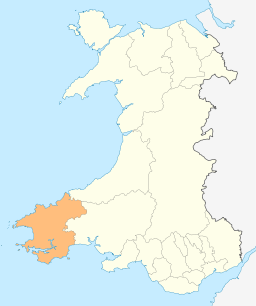Grassholm
| Native name: <span class="nickname" ">Ynys Gwales | |
|---|---|
|
Grassholm | |
| Geography | |
| Location | SM 597 093 |
| Coordinates | 51°43′52″N 5°28′47″W / 51.7311°N 5.4796°WCoordinates: 51°43′52″N 5°28′47″W / 51.7311°N 5.4796°W |
| Area | 0.09 km2 (0.035 sq mi)[1] |
| Highest elevation | 42 m (138 ft) |
| Administration | |
|
United Kingdom | |
| County | Pembrokeshire |
| Demographics | |
| Population | Uninhabited |
Grassholm (Welsh: Gwales or Ynys Gwales) is a small uninhabited island situated 13 kilometres (8 mi) off the southwestern Pembrokeshire coast in Wales, lying west of Skomer. It is the westernmost point in Wales and is known for its huge colony of northern gannets. Grassholm has been owned since 1947 by the Royal Society for the Protection of Birds, and is one of its oldest reserves. It reaches 42 metres (138 ft).
Grassholm National Nature Reserve is the third most important site for gannets in the world, after two sites in Scotland; St Kilda and Bass Rock. It serves as a breeding site for 39,000 pairs of the birds, and supports around 10 percent of the world population.[2] The turbulent sea around Grassholm also provides good feeding ground for porpoises and bottlenose dolphins.
Boats sail to Grassholm from St Davids Lifeboat Station and Martin's Haven on the mainland.
Geologically, the island is largely formed from keratophyre though the northwest coast and islet of West Tump are formed from basalt. A couple of NE-SW aligned faults cross the island. Raised beaches are present in places.[3]
Grassholm has been identified with Gwales, an island featured in the Mabinogion. In the Second Branch of the Mabinogi, Gwales is the site of a fabulous castle where the severed head of Brân the Blessed is kept miraculously alive for eighty years while his companions feast in blissful forgetfulness.[4][5]
On 15 July 1945, the cargo ship Walter L M Russ ran aground on Grassholm and sank.[6] Nine crew were rescued by the Angle Lifeboat.[7]
References
- ↑ "Grassholm Island". West Wales Biodiversity Information Centre. Archived from the original on 7 September 2008. Retrieved 30 May 2010.
- ↑ Anon. "Grassholm". RSPB wepages. The Royal Society for the Protection of Birds. Retrieved 11 April 2010.
- ↑ British Geological Survey 1978 1:50,000 scale geological map sheet (England and Wales) 226/227 Milford (Keyworth, Notts)
- ↑ "Branwen ferch Lyr: The Second Branch of the Mabinogi". www.mabinogi.net.
- ↑ The Mabinogion: Branwen the Daughter of Llyr, translated by Lady Charlotte Guest. Online at www.sacred-texts.com.
- ↑ Mitchell, W H, and Sawyer, L A (1995). The Empire Ships. London, New York, Hamburg, Hong Kong: Lloyd's of London Press Ltd. ISBN 1-85044-275-4.
- ↑ "History". Angle Lifeboat Station. Retrieved 30 May 2010.
External links
![]() Media related to Grassholm at Wikimedia Commons
Media related to Grassholm at Wikimedia Commons

